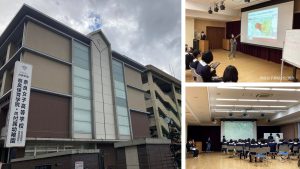Lecture at Nara Girls’ High School [Japan/HQ]
On 17th November, 2023, SEEDS Asia was invited by a teacher at Nara Girls’ High School and given an opportunity to lecture in front of Grade 7 students (approx. 90 students).
The school is focused on deepening the understanding of its students about the community through the conduct of “inquiry-based learning.” In the first semester of the year, the students explored the theme “deer and Sustainable Development Goals” by interviewing tourists, walking in the town, and receiving a lecture by the famous Todaiji temple, which led to the rediscovery of the attractiveness of their community. Such exploration also provided insights on what initiatives are sustaining the town Nara and what are the challenges faced by it.
Founded on the learning in the first semester, the students are advancing their learning about disasters that disturb the sustainability of Nara. In fact, students in Nara claim to be unfamiliar with disasters. However, there is an active fault with a high risk of earthquake in Nara City, which is also indicated by the damage recorded in the long living history of one of the oldest cities in Japan.
This also led to the lecture by SEEDS Asia titled “Is Nara actually ‘fine’?” presenting recoded disasters in Nara Prefecture and predicted damage posed by a fault line and Nankai Trough Megathrust Earthquake. Additionally, the teacher had questioned the students “Why can people not prepare despite knowing disaster risk?” To address this, the lecture discussed six biases known as the Ostrich Paradox which disturb disaster responses and preparedness. Some technologies seem effective for disaster risk reduction at a glance, but in reality, they pose side effects of catching people off guard because people feel protected by them. This highlighted the importance of looking at things from multiple perspectives. In the next semester, SEEDS Asia will work alongside the students and deepen their learning about disaster, risk reduction, and community and support their activities.
This lecture was made possible thanks to Dr Oikawa (Associate Professor at Nara University of Education and an encounter at a teacher training program for disaster risk reduction. A student from Nara University of Education who took part in the program also lectured for the same students, where the student shared their learning from Kesennuma City, Miyagi Prefecture.
